Mikhail Romanovich Shura-Bura - the patriarch of domestic programming and its development
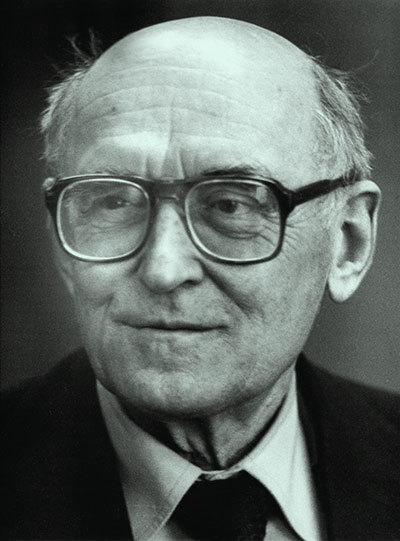
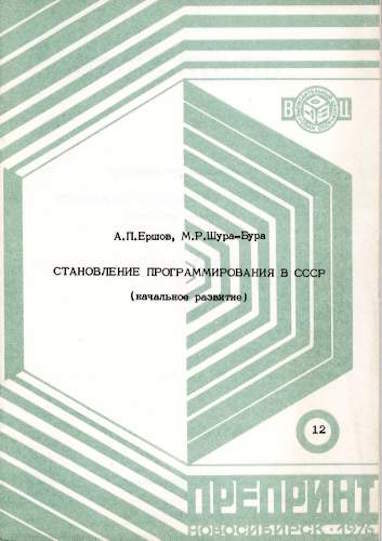
Mikhail Romanovich Shura-Bura is an excellent scientist who made an enormous contribution to the creation and development of the first domestic computers. Also known as the creator of the first software package (programming software), the interpreter of the IS-2 system for the M-20 machine. Remembering the Buran spacecraft, one can not but mention the name of Mikhail Shura-Bura, who was one of the developers of software for the ship.
Mikhail Romanovich was born on October 21, 1918 in the village of Parafievka (Ukraine, Chernihiv region), where his parents moved from Kiev, since the civil war began and it was necessary to somehow feed the family. The grandfather was a simple village blacksmith, his father graduated from the university and practiced advocacy.
Later, the parents moved again to Kiev, and things went uphill.
')
Father of Mikhail Romanovich became a successful lawyer. The conditions in which the family lived were pretty comfortable, comfortable apartment, good things. In the opera house for the family was allocated its own box. His father, being a lawyer, decided to get a second education nevertheless and entered the Polytechnic Institute, after graduating from which he began working as an engineer-economist. This wise decision saved him from persecution (and possibly death) of the intelligentsia during the years of repression. In 1933, the family moved to Moscow. At the age of 96, his father passed away. Mikhail Romanovich 's mother was from Kasimov (Russia, Ryazan region). She held not a bad position as a dentist. The family still had two daughters.
In Kiev, Mikhail graduated from a seven-year-old, in Moscow an external student for two years graduated from the following three classes (8-10). In 1935 he entered the Moscow State University in the Faculty of Mechanics and Mathematics.
Mathematics students (all!) Of the 1st year of Mechanics, 1936
After graduating from university is excellent, it was not so easy for Michael to go to graduate school. On the student's account there were many reprimands for not attending such disciplines as physical education and skipping public works. Almost burying the idea of a graduate school, Mikhail collected things to go to work as a teacher of mathematics in a village school in the Urals, but dean Lev Abramovich Tumarkin took him as an assistant to the department of the Artillery Academy. Dzerzhinsky. And for the second time in his life, fate saved Mikhail Romanovich (as was the case with his father) from destruction. Since, not enrolling in graduate school, he did not get into the university militia, which later killed most of his friends.
with closest friends
In the Artillery Academy during the war there was a need for specialists who could do ballistic calculations. Michael was one. Together with the Academy went to the evacuation of the city of Samarkand. The Academy created new types of weapons, guns and shells. Mikhail Romanovich actively participated in the calculations.
In 1944, after returning from evacuation and continuing to work at the Academy, he nevertheless joined the ranks of graduate students at the Research Institute of Mathematics of Moscow State University. In 1947, he defended his thesis on typology and was sent as a teacher at the Physics and Technology Faculty of Moscow State University. As Mikhail Romanovich recalled in one of the conversations, it was an interesting time for science. In the same year of 1947, fascinated by applied mathematics and programming, the scientist was transferred to the Institute of Fine Mechanics and Computer Engineering. Here he actively participated in setting up the machines that were created by Lebedev (BESM and Kiev MESM).
In early 1953 at the Institute of Mathematics. Steklova started working the Department of Applied Mathematics (now the Keldysh Institute for Applied Mathematics, Russian Academy of Sciences), where Mikhail Romanovich worked hard for 50 years as the head of the programming department at IPM. Along with him, graduates of the Faculty of Mechanics and Mathematics of Moscow State University I.B. Zadykhaylo, EZ Lyubimsky, V.V. Lutsikovich, T.A. Trosman, V.S. Starkman.
“How we beat Arrow!”
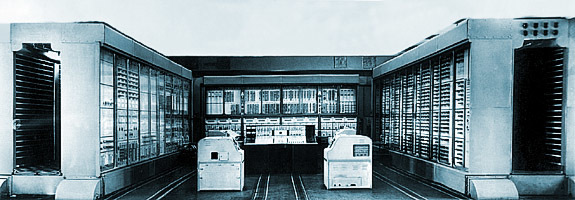
The scientists were assigned the task of theoretically calculating a thermonuclear explosion and trying to do it on a computer. A group of specialists under the leadership of KA Semendyayev was immediately created. Understandably, it all cost fabulous money and effort. For work in the department of applied mathematics computer Strela was provided.
In the Department of Applied Mathematics, Arrow was just put. The machine worked poorly, it had only 1000 cells, a non-working magnetic tape drive, frequent failures in arithmetic, and a host of other problems, but, nevertheless, we managed to cope with the task — we made a program to calculate the energy of explosions in simulating nuclear weapons, or as I said then; "We managed to defeat the Arrow!"
The arrow began to be produced in 1953. The design of the machine was a double-row rack with installation inside inter-rack corridor. Replaceable cells were inserted from the outside of each row of racks. This computer consumed 150 kW (processor - 75 kW) and occupied 300 square meters. m, of which the processor occupied 150 square meters. m. In the design of the machine was used about 6 thousand electron tubes and several tens of thousands of semiconductor diodes. Its speed was equal to 2 -3 thousand three-address commands per second, information was entered from the input device of punched cards or from a magnetic tape. Magnetic tape, card puncher or wide-format printing device were used to display information. Strela was characterized by the presence of several types of group arithmetic and logical operations, conditional jumps and interchangeable standard programs. Thanks to the systems of control tests and organizing programs, it became possible to host libraries of applied programs of various subject areas of up to 100 million teams.
Innovations “embodied” in Strela: the matrix execution of the multiplication unit on diodes was performed, the operational memory on 43 specialized storage electron-beam tubes was developed and used.
The arrow turned out to be the ideological opponent of BESM. Sergey Alekseevich Lebedev's car was more advanced, more promising, with good arithmetic, but Strela - because there was more money in industry, better supply than at an academic institute, was, let's say, more carefully made. Both machines were developed almost at the same time: Strela - in SKB-245 of the Ministry of Instrument Engineering, BESM - in ITM and VT, however, in different conditions. The Ministry "made a bet" on the Arrow and did not spare anything for it. For example, if potentialoscopes were issued for memory in Strela, then BESM was content with memory on mercury tubes, and even those Lebedev had to beg, which he repeatedly complained about. BESM was a good, great car, but ... it could not be repeated. She was still more of a mockup, and not a machine, ready for serial production. It did not even contain such documents, according to which it could be issued by industry.
Due to the unstable operation of computers, the calculations for simulating an atomic explosion had to be broken down into stages. Each stage was performed at least two or three times with the creation of control points that ensured the continuation of the experiment without returning to the previously performed calculations. It was with such difficulty that we managed to defeat the Arrow.
In 1955, Mikhail Romanovich was awarded the USSR Stalin Prize for his contribution to the development of nuclear weapons.
The team of IPM programmers was able to create the most complex programs, including for solving problems related to space. As Mikhail Romanovich recalled, their department resembled a programming hotbed. Having experienced the difficulty of manual programming in full volume, before the department there was a question about programming automation: "... At IPM, we, in particular, began to teach programming to everyone around. When there was a big task, we unfastened a group of people to another department, which over This task worked. It turned out that thanks to our “landing” the department staff learned programming and, moreover, some of the “paratroopers” in these departments remained on a permanent job. "
At the beginning, such an automation activity even caused a storm of negativity from the mathematical departments, at party meetings the question was raised that the staff of the IPM department occupied computers for “toys”. They worked out the technology of passing tasks, double miscalculations, check summations, while improving the quality of programs in Strela.
Such work was paid very well, awards were often allocated. For two months, Mikhail Romanovich could receive up to 16,000 rubles, and this was a huge amount at that time.
The programs that were developed by the department headed by Mikhail Romanovich in the mid-50s for the Strela and M-20 computers were used to calculate artificial satellites of the Earth; they provided round-the-clock processing of measurements of the satellite trajectories. The accuracy of the trajectory calculations was very important and when the first satellites were launched and Gagarin’s flight, the programs were used until 1967. All calculations were carried out lively, which required tremendous efforts from specialists. After all, not everything was so smooth: "... the satellite flies, information comes through the communication lines, operators punch cards, we have to shove them into the car in the hall, we must assume, and here they call from the flight control, and then the car broke down. One in short, a nightmare! "
In 1963, under the direction of Shury-Bura, one of the three translators from the ALGOL-60 language for the M-20 computer was created - the TA-2 translator with the full version of the ALGOL-60 language.
Installation on M-20 translator ALGOL-60
ALGOL-60 as well as the most common and well-known programming languages such as Fortran, Kobol, PL-1, Algol-68, Pascal, Ada actually belong to the same family, based on the class of operator languages, procedural type. A typical language for describing and representing algorithmic knowledge.
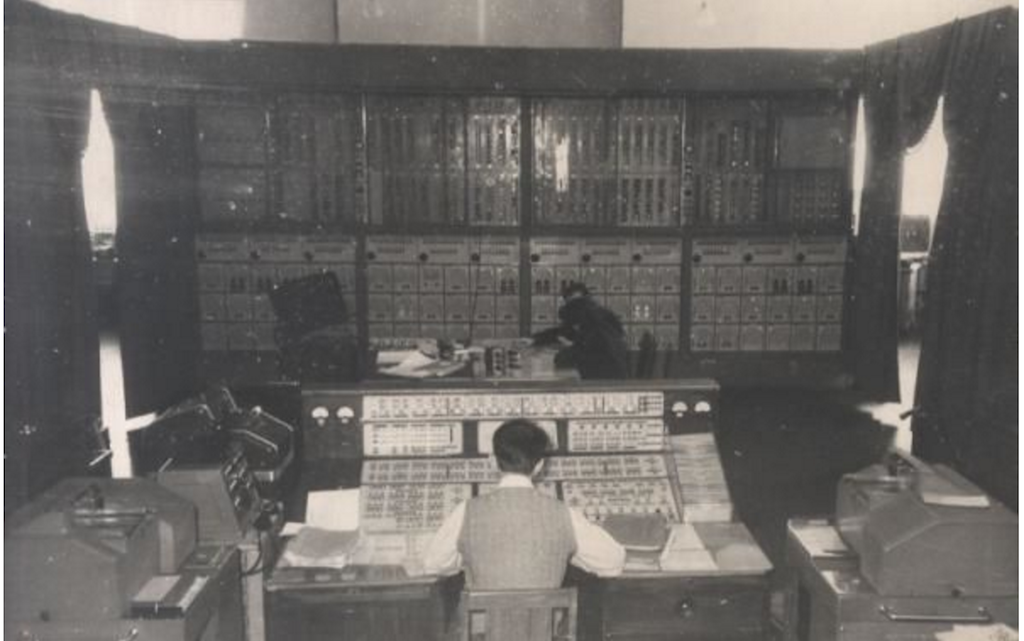
COMPUTER M-20
Later, the staff of the department under the “close” guidance of Mikhail Romanovich developed programming systems for BESM-6 and other computers.
Space Shuttle Buran
In the 80s, Turchin, who was a member of the department of Mikhail Romanovich, developed a system programming tool for developing compilers in IPM - the well-known REFAL.

REFAL technology was used to create FORTRAN compilers for PS-3000, EC 1191 computer, scalable compiler for onboard module of Buran spacecraft, software for specialized equipment products Bulat 2, Bulat 3
The reusable orbital ship (in Minaviaprom terminology - the orbital plane) the Buran or, as it is also called, the Soviet shuttle. In the 70s, after the information about the American program of space shuttles "Space Shuttle" appeared, it was decided to immediately build a domestic reusable ship. In 1981, everyone who worked on the creation of Buran was "... ordered not to sleep, not to drink, not to eat, but quickly to make our Soviet alternative to Colombia, which the Americans had already launched before that time.
Many different organizations were involved in the project. In a word - Buran was made by the whole country. Programmers interacted with each other and with onboard systems specialists. The problem of programming languages became acute, ensuring the effective cooperation of all developers of the program part of the orbital spacecraft control system.
President of the USSR Academy of Sciences G. I. Marchuk hands over the Order of Lenin for the work on the Buran project
The program department of Mikhail Romanovich Shury-Bura took an active part in creating a complex of languages for writing source codes of programs and tools that would allow moving from source texts to spent, tested, properly modeled object codes stored in on-board and ground equipment.
The joint efforts of programmers and onboard systems specialists created two programming languages - PROL-2 (a special problem-oriented real-time programming language based on Russian service words) for developing onboard systems and Dipole for developing ground-based verification software, as well as a special object description language. Phlox, which ensured their integration with each other, the Lax modeling language. Later, these three languages were replaced by one universal, convenient and well thought out - graphic language DRAGON .
The merits of the office of PM Mikhail Romanovich Shury-Bura
The creation of EU computers and computer systems was the largest joint project of the socialist countries. The project implementation was attended by 20 thousand scientists and designers, 300 thousand workers and technicians in 70 factories.
In 1979, in the socialist countries, 240 types of EC electronic devices were developed. Over the years of cooperation, 31 types of processors have been developed, of which 17 are in the USSR.
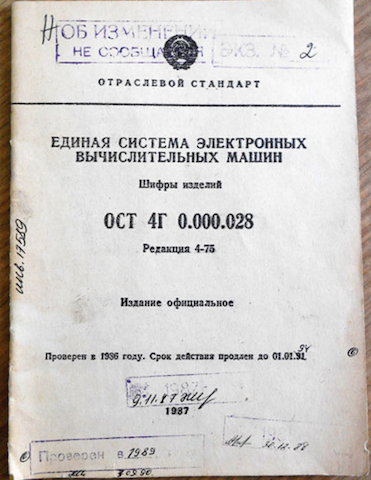
All this did not occur without the participation of the department of programming of the PMM Mikhail Romanovich. Their task was to ensure the software compatibility of the EU computer with the most common in the West family - IBM / 360. At seminars that were devoted to this problem, IBM / 360 architecture and software were studied.
In 1978, work was completed on the development of EU software (unified system) of computers. For this, Shura-Bura was awarded the USSR State Prize.
Another merit of the Shury-Bura department was the creation of the original architecture of the scalar-vector multiprocessor EC computer 1191, although this machine could not be called successful because only the domestic element base was used, which was significantly inferior to the western one (1.5 thousand gates / crystals compared to 200 thousand). But its software corresponded to the world level.
Creations of the operating system for the computer Spring - you also need to write to the account of the Department of Applied Mathematics, Mikhail Romanovich. It was the first fully-functional operating system in the USSR for a serial computer that supported multi-program mode, batch processing and time-sharing mode.
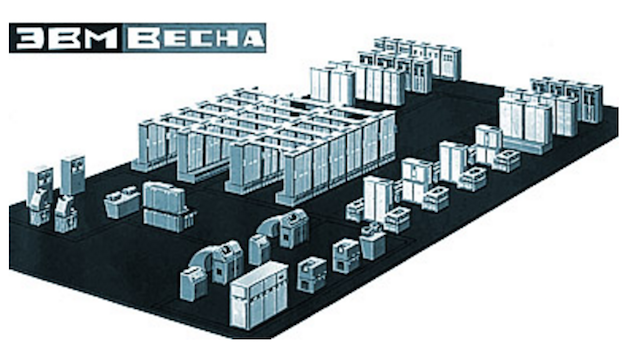
High Performance General Purpose Solid State Semiconductor Computer Spring
The creation and implementation of the non-procedural programming language Norma was also carried out by the program department under the guidance of Shura-Bura. The primary elements of the Norma language are symbols (letter, number, and special characters). Identifiers can have any length, the number of significant characters is defined in the description of the input language of the translator, the letters of the upper and lower registers differ, the type and value of the constant is determined by the way it is written.

Keywords

Write constant
'Hello, world!'
'Ob''m the body'
Line entry
Studies in the field of the theory of the complexity of computations and logic programs have become widely known in the country and abroad. Many results obtained at IPM in the field of the complexity of computations and logic programs became the theoretical basis for the creation of large instrumental automation systems for logical programming (for example, the GESIOD system).
The scientist devoted much time and attention to the training of young specialists, his pupils were several generations of highly qualified programmers. The first textbook on programming was written in collaboration with Lyusternik, Abramov, Shestakov ("Programming for electronic computers")
As one of the founders of computer science in the USSR, Mikhail Romanovich Shura-Bura made a significant contribution to the creation and development of the first samples of computers. He was a pioneer of programming automation, the creator of the first in the USSR PP. His work played a crucial role in the spread of algorithmic languages in the USSR as a programming tool. Under the leadership of Mikhail Romanovich, the first in the USSR translator from the full language Algol-60 was created, the interpretive system IS-2 was developed for the M-20 machine.
His contribution to the design of domestic computers is enormous. Shura - Bura developed the logical structure of the machine M-20, the logic and system of multiprogramming computer Spring.
Decisive was his contribution to the creation of the Buran spacecraft software.
In 1970–1991, Mikhail Romanovich Shura-Bura was a professor and head of the system programming department at the Faculty of Computational Mathematics and Cybernetics (VMIC), Moscow State University.
In the museum of astronautics. Washington, 1992
The eminent scientist, creator of computer technology, Mikhail Romanovich Shura-Bura, died on December 14, 2008 at the age of 90 years. His time was saturated with practically round-the-clock work, because, as he said, he was at the forefront of science.
Mikhail Romanovich with family
According to tradition, a little advertising in the basement, where it does not hurt anyone. We remind you that due to the fact that the total network capacity of the Dutch data center where we provide services has reached 5 Tbit / s (58 points of presence, including 36 points of exchange, in more than 20 countries and 4213 peering inclusions ), we offer dedicated servers for rent at incredibly low prices, just a week!
Source: https://habr.com/ru/post/274851/
All Articles